German helmet
Showing 7681–7740 of 16177 results
-

Aluminium ID disc or Erkennungsmarke 5./ I.R. 274
Aluminium ID disc or Erkennungsmarke marked 5./ I.R. 274. which indicates 5e Kompanie Infanterie Regiment 274. This regiment was part of 94 Infanterie Division which took part in the Westfeldzug (Luxemburg & France) & Ostfeldzug (Russia). The unit was later renamed to Grenadier Regiment 274 and saw action in Italy. This unit was encircled in Stalingrad, where this tag was found!
-

Zinc ID disc or Erkennungsmarke Stammkp. Pz. Ers. Abt. 7
Aluminium ID disc or Erkennungsmarke marked Stammkp. Pz. Ers. Abt. 7. which indicates Stamm Kompanie Panzer Ersatz Abteilung 7.
-

Matching Heer shoulderboards for a Leutnant der Infanterie
Nice original pair of Heer shoulderboards for a Leutnant der Infanterie.
-
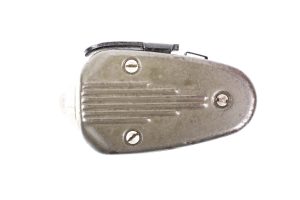
Philips “Knijpkat” type 7424-03 torch
Typical wartime “Knijpkat” torch. These flashlights where made utilizing forced labour from Konzentrationslager Herzogenbusch. Unlike most of the wartime used flashlights the “knijpkat” doesn’t have a battery but uses a small internal dynamo. The mechanism is still in great condition and the torch still works!
-

Philips “Knijpkat” type 7424-03 torch
Typical wartime “Knijpkat” torch. These flashlights where made utilizing forced labour from Konzentrationslager Herzogenbusch. Unlike most of the wartime used flashlights the “knijpkat” doesn’t have a battery but uses a small internal dynamo. The mechanism is in working condition but sometimes it falters a bit which is not disruptive. The “knijpkat” is in further mint condition and would look perfect in a display!
-

US Mess tin with British Made pouch
Great complete US Army mess tin complete with all 3 parts of cutlery. All of this is complete in its original British Made pouch.
-

US wireless handset BC-611-C Handie Talkie 1944
Superb US handheld BC-611-C Wireless set in unissued condition. The set comes with its original serial plate and fully retractible antenna. Nicely dated 1944! The set retains up to 99% of its original textbook factory crinkle paint and would be very hard to upgrade.
-

US Navy N1 field shoes Boondockers A. Freedman & Sons Inc. April 1944
US navy N1 field shoes Boondockers. The shoes are nicely marked A. Freedman & Sons Inc. NXSX 56436. NXSX 56436 indicates production in April 1944. The shoes are size 8 1/2 (European size 41). Rare US navy N1 Boondockers in near mint condition!
-
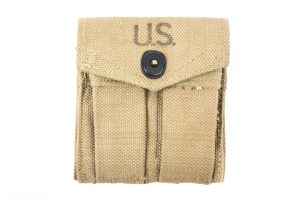
US M1 carbine magazine pouch British Made
US M1 carbine magazine pouch British Made.
-

US Colt magazine pouch British Made
US Colt 1911 magazine pouch marked M.E.C.1943 British made.
-
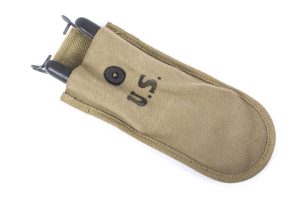
Mint US wire cutters marked J.S.& S.Co. 1942.
A nice set of US wire cutters in good mint condition marked J.S.& S.Co. 1942.
-
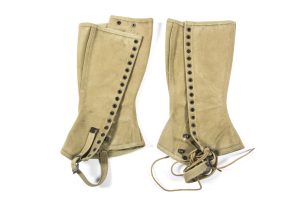
CC2 Impregnated US M1938 leggings Gregory & Read Co. size 3R
Rare CC2 Impregnated M1938 Leggings marked Gregory & Read Co. 9-30-1942 size 3R.
-
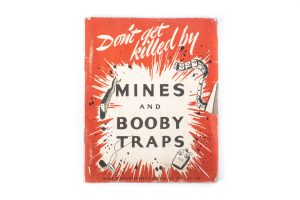
US manual; Don’t get killed by mines and booby traps
Rare original 80 page long US manual; Don’t get killed by mines and booby traps. This pamphlet was issued due to the many boobytraps and mines used by Japanese and German forces during world war two. It illustrates most if not all explosives commonly used by the axis forces.
-
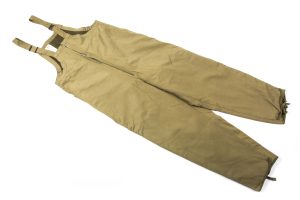
US first pattern Tanker winter trousers MacLaren Sportswear 1942
Mint unissued first pattern US tanker winter trousers with the paper label marked MacLaren Sportswear Ltd. Inc. Dated Mar. 6, 1942. The Trousers are a size medium and would be impossible to upgrade.
-
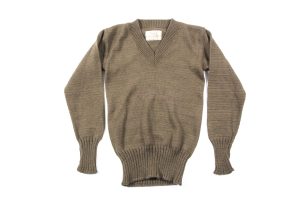
US v-neck sweater Carthage Knitwear Corp October 16 1944
Sweaters, V-Neck size 38 Small Carthage Knitwear Corp dated October 16 1944
-
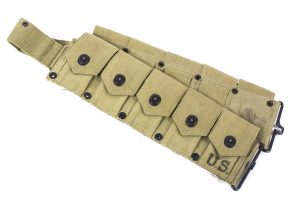
US M1 Garand cartridge belt named Anderson
Excellent unissued US M1 Garand cartridge belt without any damage or wear named Anderson.
-
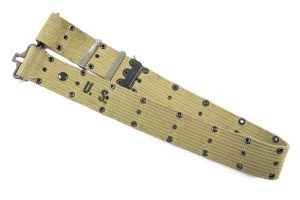
US pistol belt
Mint US M1936 pistol belt
-
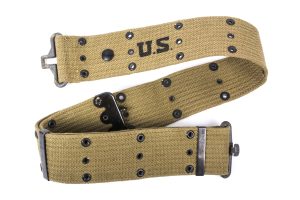
US pistol belt
Original M1936 US pistol belt in unissued condition.
-
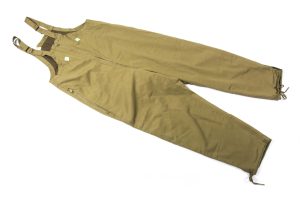
US first pattern Tanker winter trousers with cutter tags
Mint unissued US tanker winter trousers marked small – which still is a large size as they were meant to be worn on top of other uniforms. Complete with all cutter tags!
-
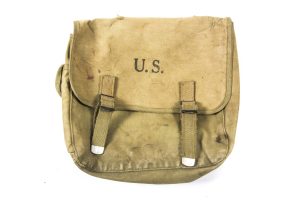
Rubberized US M1936 musette bag marked THE LANGDON TENT & AWNING CO Manufactured in 1942
Textbook US rubberized musette bag marked THE LANGDON TENT & AWNING CO Manufactured in 1942.
-

US M1938 leggings George S. Rumley Co. 10-26-1943 size 2R
Leggings, Canvas, M1938, Dismounted (O.D.) George S. Rumley Co. 10-26-1943 size 2r
-
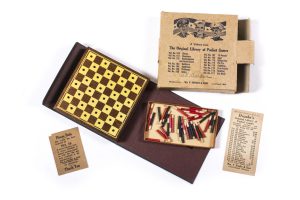
US Pocket games Checkers Wm. F. Drueke & Sons
Neat original pocket edition Checkers game. These small and popular games were used by the troops to overcome the often long waits on and behind the front. Produced by Wm. F. Drueke & Sons. Nice personal item in good and complete condition!
-

Deathcard to Wilhelm Steiner KIA 28.11.44 in HOUTEN, the Netherlands
Deathcard to Wilhelm Steiner, killed in action 28.11.1944 in Houten, Holland.
-

Fallschirmjäger deathcard to Johann Altmann KIA 18.1.1945
Original deathcard to Johann Altmann, Obergefreiter in a Fallschirmjäger unit. He was killed in action in the Netherlands in Niederrhein.
-

Deathcard to Alois Basten KIA 25.2.45 in Venray
Deathcard to Obergefreiter Alois Basten, KIA 25.2.1945 in Venray, Holland. He is buried in Ysselsteyn.
-
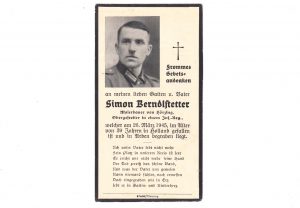
Deathcard to Simon Berndlstetter KIA 26.3.45 in Vorden, Holland
Deathcard to Simon Berndlstetter, KIA 26.3.45 in Vorden. He is buried in the grave of 11 soldiers of which most died at the crash of a Junkers Ju 88 after a air battle.
-

Deathcard to Anton Engelmeier KIA 10.5.40 Rotterdam
Rare deathcard to Anton Englmeier, Killed in action in Rotterdam on 10 may 1940 during Fall Gelb. Anton Engelmeier served in 6. (MG)Kompanie Infanterie Regiment 72. It’s very rare to find any document relating to the 1940 invasion, especially dated 10.5.40. The deathcard says he was killed the 11th, but it is actually 10 may. He was first buried in the Krooswijk cemetery but was moved to Ysselsteyn later.
-

Deathcard to Hans Loher 11.10.44 Utrecht
Deathcard to Hans Loher, Gefreiter in a Grenadier Regiment who died 11.10.44 in Feldlazarett Utrecht, in the Tolsteeg. He is buried in Ysselsteyn.
-

Deathcard to Matthias Mangold, KIA 15.4.1945
Deathcard to Unteroffizier Matthias Mangold, KIA 14.4.1945. He is buried in Ysselsteyn.
-

Flieger deathcard Wilhelm Leopold Roitinger, KIA 26.9.44 Neede-Rietmolen Gelderland
Rare deathcard for Flugzeugführer Wilhelm Leopold Roitinger who was shot down 26.9.44 at Neede-Rietmolen in Gelderland, the Netherlands. He flew with 4.Jgr. West with a Focke Wulf 190 when he was shot down after a air battle at 14.50 hrs.
Some more information is found here, but being a Flugzeugführer who died in an air battle, there is probably more to be researched.
-
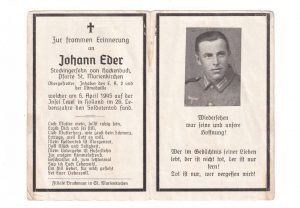
Rare Texel deathcard to Johann Eder KIA 6.4.1945 during Georgian uprising
Original deathcard to Obergefreiter Johann Eder was a German soldier killed in action during the infamous Georgian uprising of the island Texel. The Georgian ‘volunteers’ stationed a coastal battery on the Island, north of the Netherlands defending the North Sea.
Shortly after midnight on the night of 5–6 April 1945, the Georgians rose up and gained control of nearly the entire island. Approximately two hundred German soldiers were killed in the initial uprising, in their quarters or while standing guard, walking the roads of the island in groups or individually that night and the following day. Members of the Dutch resistance participated and assisted the Georgians. However, the rebellion hinged on an expected Allied landing which did not occur. Furthermore, the Georgians failed to secure the naval batteries on the southern and northern coasts of the island; the crews of these artillery installations were the only Germans still alive on the island.
A counterattack was ordered and the intact artillery batteries on the island began firing at sites where rebels were suspected to be. Approximately 2,000 riflemen of the 163rd Marine-Schützenregiment were deployed from the Dutch mainland. Over the next five weeks they re-took the island; fighting was particularly heavy in the northern part of the island at Eierland and around the lighthouse. The German troops then combed the length of the island for any remaining Georgian soldiers, while the Dutch inhabitants sought to hide them. The German commander of the 882nd battalion, Major Klaus Breitner, stated long after the war that the uprising was “treachery, nothing else;” the captured mutineers were ordered to dig their own graves, remove their German uniforms, and be executed.
During the rebellion, 565 Georgians, at least 812 Germans, and 120 residents of Texel were killed. The destruction was enormous; dozens of farms went up in flames, with damage later estimated at ten million guilders (US$3.77 million). The bloodshed lasted beyond the German capitulation in the Netherlands and Denmark on 5 May 1945 and even beyond Germany’s general surrender on 8 May 1945. The fighting continued until Canadian troops arrived 20 May 1945 to enforce the German surrender, and disarmed the remaining German troops.
Rare original deathcard!
-

Texel deathcard to Civilian KIA 6.3.1945 during Georgian uprising
Original deathcard to Harmanus Willibrordus Timmer, married to Annie W. Witte ( a typical name in Den Burg, Texel ) was killed in action during the infamous Georgian uprising of the island Texel. The Georgian ‘volunteers’ stationed a coastal battery on the Island, north of the Netherlands defending the North Sea.
Shortly after midnight on the night of 5–6 April 1945, the Georgians rose up and gained control of nearly the entire island. Approximately two hundred German soldiers were killed in the initial uprising, in their quarters or while standing guard, walking the roads of the island in groups or individually that night and the following day. Members of the Dutch resistance participated and assisted the Georgians. However, the rebellion hinged on an expected Allied landing which did not occur. Furthermore, the Georgians failed to secure the naval batteries on the southern and northern coasts of the island; the crews of these artillery installations were the only Germans still alive on the island.
A counterattack was ordered and the intact artillery batteries on the island began firing at sites where rebels were suspected to be. Approximately 2,000 riflemen of the 163rd Marine-Schützenregiment were deployed from the Dutch mainland. Over the next five weeks they re-took the island; fighting was particularly heavy in the northern part of the island at Eierland and around the lighthouse. The German troops then combed the length of the island for any remaining Georgian soldiers, while the Dutch inhabitants sought to hide them. The German commander of the 882nd battalion, Major Klaus Breitner, stated long after the war that the uprising was “treachery, nothing else;” the captured mutineers were ordered to dig their own graves, remove their German uniforms, and be executed.
During the rebellion, 565 Georgians, at least 812 Germans, and 120 residents of Texel were killed. The destruction was enormous; dozens of farms went up in flames, with damage later estimated at ten million guilders (US$3.77 million). The bloodshed lasted beyond the German capitulation in the Netherlands and Denmark on 5 May 1945 and even beyond Germany’s general surrender on 8 May 1945. The fighting continued until Canadian troops arrived 20 May 1945 to enforce the German surrender, and disarmed the remaining German troops.
-
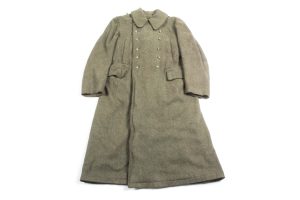
Named late war Waffen-SS Wachmantel
A late war hooded Waffen-SS Wachmantel in good used condition. Nicely marked 2392/43 and named to Bechler. A lot of these mantels can be seen in pictures of the Ardennes offensive worn by members of Kampfgruppe Hansen and in and around La Gleize. These mantels where specifically made for the Waffen-SS and lack the french cuffs the Heer types have. The mantel shows a lot of wear and age and would make a great addition to a late war Waffen-SS combat mannequin!
-

Feldgendarmerie gorget
A stunning original field police gorget or Feldgendarmerie Rinkragen. Hard to find in a stunning condition like this one. The luminous paint still lights up in the dark. The Gorget is a nice mid to late war example with a wool back and is nicely marked with an M in a diamond shaped logo. The consensus among collectors is that this M logo indicates production by the company J.C. Maedicke, Berlin. Very hard to find in this condition and a centerpiece in any Feldgendarmerie display!
-
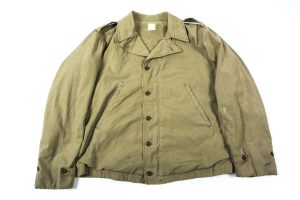
US M1941 field jacket
Nice original M1941 field jacket in good used condition. The jacket shows wear at the collar but is otherwise undamaged and a good medium size. The jacket retains its working Talon zipper and most if not all of its wartime sewn buttons.
-

Rare ZF4 ddx. sniper scope with textbook WaA214 Berlin Lubecker production mount
Beautiful untouched ZF4 sniper scope with textbook period applied mount, uncleaned and untouched as recently found. The scope is in untouched, useable and adjustable condition. The scope itself is a textbook example marked dow which indicates production by Opticotechna GmbH. The mount is a gorgeous textbook example marked with the Waffenamt 214 which indicates production by Berlin Lubecker. The scope is a beautiful and completely functional example that would be a great addition to any G43 with a scope rail!
-

Hitlerjugend buckle with late war Pressstoff buckle
Textbook late war Presstoff Hitlerjugend equipment belt with buckle marked M4/23 indicating production by Dr. Franke & Co. The belt and buckle are in as new condition with most of the silver was retaining to the back of the buckle. The belt was period shortened with the tongue moved which is a typical wartime feature.
-

Camouflaged M17 helmet
Rare original first world war German M17 Mimikri camouflage helmet in good, as found condition. The helmet retains up to 85% of its original wartime applied camouflage paint. The shell is a nice large size 66. The helmet is without liner but regardless a textbook example that would be hard to upgrade.
-
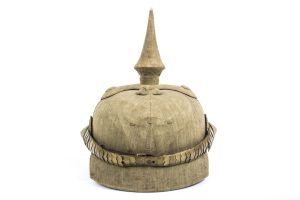
Spectacular one of a kind and published officer Pickelhaube
Excellent first world war privately purchased officers helmet made by Ludwig Bortfeldt, Bremen. This helmet is thé cover helmet pictured on Feldzug, Volume 1 by Michael Baldwin. The helmet is a well known and well documented example; probably one of the most wanted examples out there. Underneath is a quote from Michael Baldwin’s observations on this very helmet from Feldzug, volume 1.
The helmet was for an officer in an unidentified Dragoon regiment. It was much more difficult to construct than the previous Sharko: The whole body is made of cloth-covered cork including the peaks, as is the silhouetted front plate, visible under the cloth covering as well as the cockades. All the other helmet furniture is cloth0covered metal, apart from the uncovered, raw brass, convex mounted, troop styled chin scales. There is another identical helmet among the very large helmet collection in the Fort De La Pompelle, a very good museum just outside of the city of Reims, France. This helmet has uncovered chin scales. It may transpire that this was a Bortfeldt feature but this is my own speculation.
There is a glued repair to the spike at some time in the past and the lower portion shows evidence of previously having eyelets/grommets in the ventilation holes. There are six sewn cotton retaining loops to the front of the badge and four to the rear. Although now missing, these would have held in place red woolen regimental numbers which were mounted on the same type of cloth that is covering the helmets exterior, when required for field manoeuvres or wartime service.
This is a spectacular helmet is exceptionally rare and can be seen on the cover and extensively photographed inside of Feldzug, Volume 1 – making this one of the most desirable first world war Pickelhauben on the market today!
-
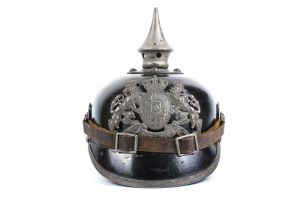
Bavarian EM M1915 Pickelhaube
Excellent Bavarian first world war M1915 EM Pickelhaube with the crest for Bayern. The Pickelhaube is in good, untouched condition and would be very hard to upgrade.
-
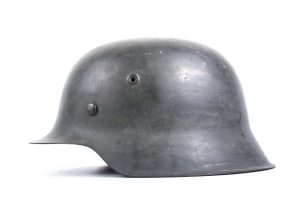
CKL66 M42 no decal helmet
Textbook late war M42 no decal helmet marked CKL66 indicating production by Eisenhuttenwerke Thale. The helmet retains its factory installed liner. The helmet has a interesting CKL marking with the ‘K’ upside down.
-

ET64 M40 single decal Luftwaffe helmet
Textbook M40 Luftwaffe helmet marked ET64 indicating production by Eisenhuttenwerke Thale. The helmet is a textbook M40 single decal example with up to 90% of its factory finish and with its factory installed liner with chinstrap.
-
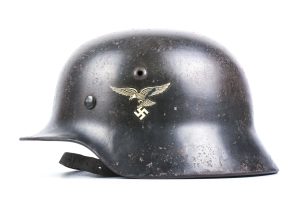
ET64 M35 double decal droop tail Luftwaffe helmet
Textbook Luftwaffe double decal M35 helmet with straight leg ‘droop tail’ eagle. The helmet is marked ET64 indicating production by Eisenhuttenwerke Thale. The helmet is a nice example retaining up to 90% of its factory finish. The liner and chinstrap are original to the helmet but the short part of the chinstrap has snapped. The helmet is a nice and textbook example; hard to upgrade.
-
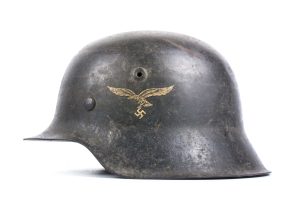
Rare ET60 M42 single decal Luftwaffe helmet
Rare small M42 helmet marked ET60 indicating production by Eisenhuttenwerke Thale. The helmet is a rare size 60 example which are nearly as rare as the size 70 helmets. The helmet retains most of its factory finish and decal and would be hard to upgrade.
-
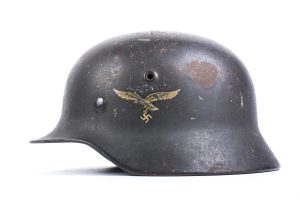
Q64 M40 single decal Luftwaffe helmet
Textbook M40 Luftwaffe helmet marked Q64 indicating production by Quist. The helmet is a textbook M40 single decal example with up to 90% of its factory finish and with its factory installed liner.
-
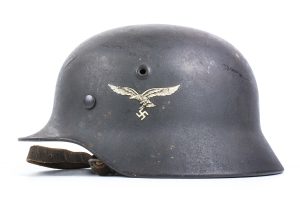
Q64 M40 single decal Luftwaffe helmet
Excellent Luftwaffe M40 helmet marked Q64 indicating production by Quist. The helmet retains its factory installed liner and chinstrap marked L.L.G. Hessen which is a typical maker found on Luftwaffe helmets. The helmet retains up to 95% of its factory finish and decal and would be hard to upgrade!
-
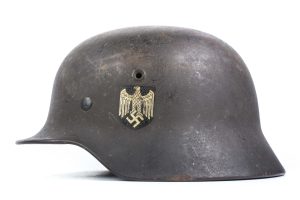
ET64 M40 single decal Heer helmet
Textbook single decal Heer M40 helmet marked ET64 indicating production by Eisenhuttenwerke Thale. The helmet retains its factory installed liner and period installed, partially damaged chinstrap. The helmet retains up to 95% of its factory paint and decal. Excellent and textbook helmet that would be hard to upgrade.
-
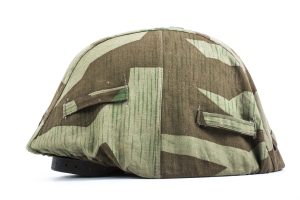
Splittertarn helmet cover marked PC SS 03208
A textbook and minty original German Heer helmet cover in Splittertarn or splinter camouflage. The cover is photographed on a size 64 shell but would also fit a size 66 shell. The cover is marked inside with P.C. indicating Pathé Costumes. The cover is in absolute mint condition and shows no signs of use or postwar alterations.
-
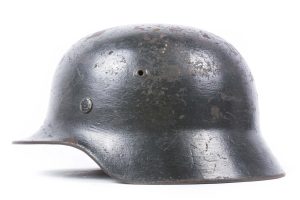
SE64 field repainted M35 helmet for Heer / Küstenartillerie
Very nice and aesthetic combat helmet. Field repainted in field grey on top of a reissue on top of the factory apple green paint. The helmet retains its original liner and chinstrap. The helmet is a very nice example of a helmet that was first issued in the Heer and later repainted in the field. The grey top colour is typical for coastal artillery. The helmet retains its original factory fitted non-reinforced liner. The back of the helmet and the liner are both named Gros.
-

Soldbuch Grouping to Stabsgefreiter Richard Reis 6. Fallschirm-Jäger-Division – Arnhem, Reichswald
Large Soldbuch grouping to Stabsgefreiter Richard Reis, serving in various Luftwaffe Sanitäter and Flak units from 1943 onwards. He was transferred to Flak Regiment 172 and later to Luftwaffe Sanitäts Staffel Berlin. He was transferred early July 1944 to 2. Kompanie Sanitäts-Ausbildungs Abteilung der Luftwaffe. 4.10.44 he was transferred to Fallschirm Pionier Abteilung 6, which served under the 6. Fallschirmdivison which at that point was reorganized. On 19 November 1944 the division moved to the front, north of the Waal, south east of Arnhem at Elst, Valburg, Zetten and Opheusden. On 20 December they moved to the Waal-Bogen at Hasselt. On the 8th of February 1945 the British offensive in the Reichswald started and the 6.th Fallschirmdivision took part in heavy fightings over Kalkar, Moyland, Marienbau, Xanten, Wesel, Emmerich and Praest. In march 1945 the division was pushed back to the rail line Doetinchem, Treborg, Varsseveld and Aalten. Early April 1945 the division moved through Zutphen, Hengelo, Holten and Hellendoorn. Between 17 and 19 April 1945 the division fought off multiple armoured attacks at Zutphen, Voorst, Bussloo and Deventer. 20 April 1945 the division moved to new defensive lines west of Apeldoorn between Hoenderloo, Apeldoorn, and Vaassen. Early May 1945 they extended to Amersfoort, Nijkerk and Putten. This is where they go into British captivity.
The grouping consists of the Soldbuch, a number of portraits and photographs, his EKM and various personal and POW documents. The grouping is a good base for further research. The Soldbuch is in strong worn condition and there are some pages missing. I have scanned all present filled pages. A excellent grouping with tons of potential further research!
-
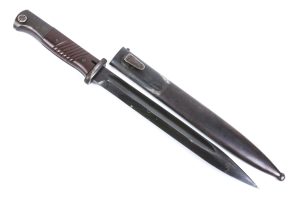
Matching K98 bayonet marked 43 asw
A nice matching bayonet marked 43 asw indicating production by E. & F. Horster & Co. Solingen. The blade has not been sharpened retaining most of its original blueing. The bayonet is matching to its scabbard with the serial 5047 and has nice clean red bakelite grips.
-

Matching K98 bayonet marked 41 ffc
Matching K98 bayonet marked 41 ffc indicating production by Friedrich Herder Abr.Sohn, Solingen.
-

Matching K98 bayonet marked 41 ddl
Matching K98 bayonet marked ddl 41 indicating production by Josua Corts Sohn, Remscheid in 1942. The bayonet is matching to its scabbard with the serial 5272f and has nice clean bakelite grips.
-
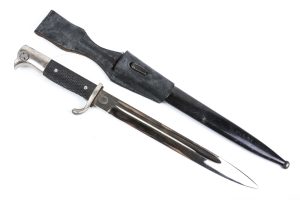
K98 dress bayonet marked E.u.F. Hörster
Excellent original K98 Dress bayonet with brown leather frog and red felt insert. The bayonet is marked E.u.F. Hörster and is in unsharpened and uncleaned condition.
-

Carrying strap for MGZ40 optics can
Mid to late war carrying sling for the MGZ40 optics can. Complete strap, easily attached and or detached. Hard to find spare!
-
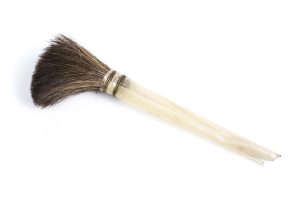
Rare brush for MGZ40, ZF41 and ZF4
Rare original dust brush for the Wehrmacht issue optical devices such as the MGZ40, ZF41 and ZF 4. The brush is in perfect condition.
-
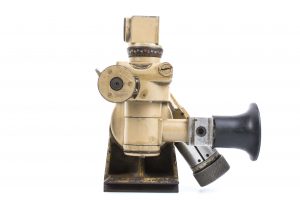
DHQ marked MGZ scope with original eyecup
Stunning tan MGZ40 sight for the MG34 and MG42 Lafette. The sight is clear fully adjustable condition. The glass is all in good condition without damage; the lenses are clear and 100% usable. The original rubber eyecup is original and present. Perfect usable piece in full original finish!
-
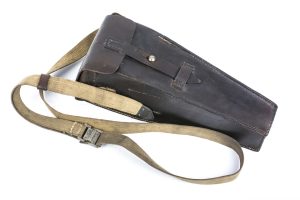
K98 grenade launcher pouch DKK43
A leather pouch for the K98 grenade launcher with its original sling. Nicely marked dkk 43 indicating production by Friedrich Offermann u. Söhne, Lederwarenfabrik, Bensberg.
-

Late war MG34 and MG42 tool pouch in presstoff
Great late war MG34 and MG42 tool pouch in unissued condition. The pouch does not have any internals which is exactly how this model should be. The pouch is in very good, never used condition!
-
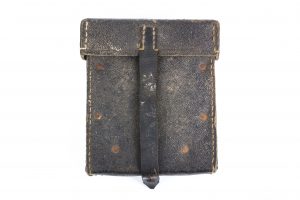
MG34 u. MG42 tool pouch gym 1943
Original MG34 and MG42 tool pouch complete with internal dividers. Nicely marked on the strap GYB 1943. The point of the strap has a small period repair.
Showing 7681–7740 of 16177 results


